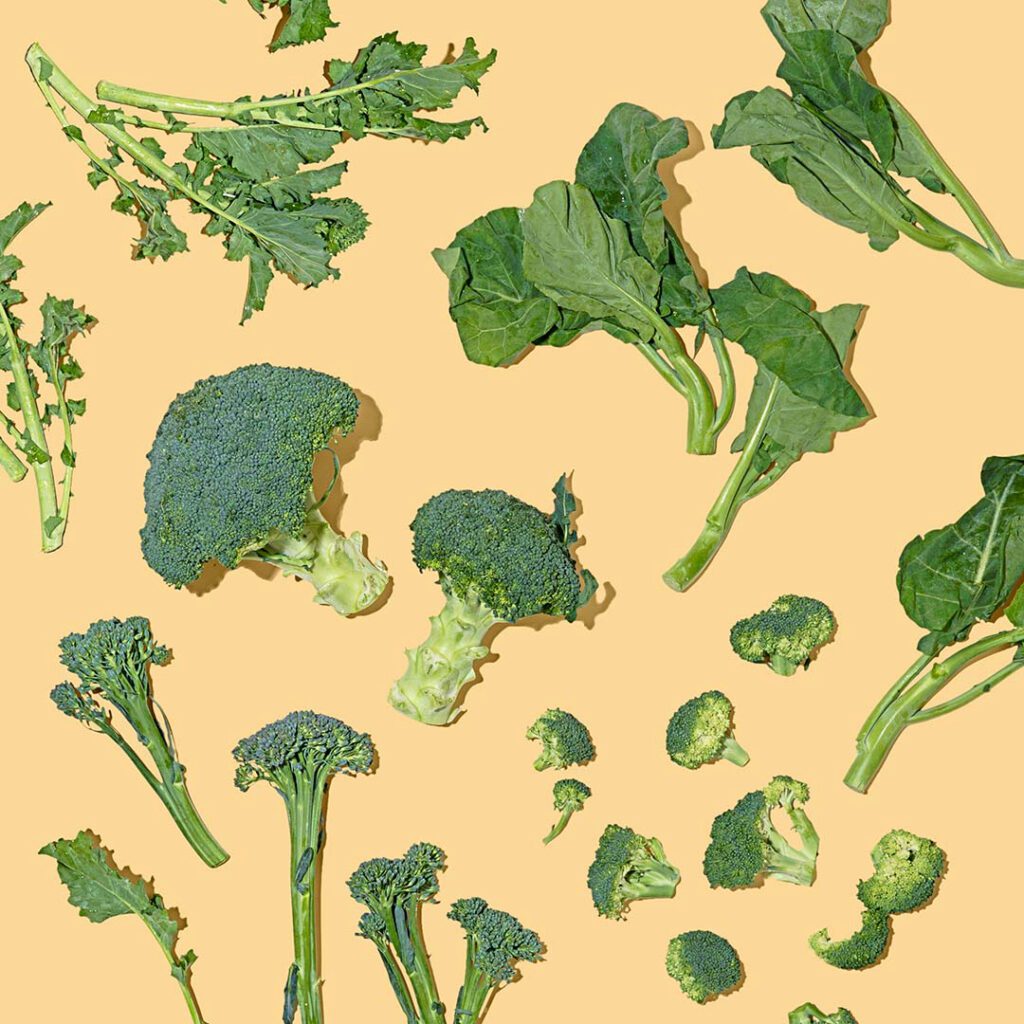
Kale and cauliflower might be more of-the-moment veggies, but broccoli will always be a staple in our kitchens. Broccoli florets, stalks, and leaves offer endless cooking versatility—not to mention the number of varieties with flavors that range from fresh and sweet to vegetal and bitter, and everything in between.
Broccoli is a powerhouse in the kitchen and (thankfully) readily available all year long. Though we’re extra flush with thick, luscious broccoli in the fall and winter months, spring brings with it the more tender varieties, like broccolini and broccoli rabe.
Dive into our guide to learn a bunch about these brassicas and their many tasty applications.
THE LINGO
Crowns
While the tough stalks of your typical bunched broccoli can be eaten (just peel off the rugged outer layer first!), we sometimes ship the heads alone for floret fans. A broccoli crown or two gives you your staple for broccoli cheddar soup, ample florets for roasting, or a solid base for broccoli slaw.
Leaves
Bunched broccoli doesn’t just look like a bouquet—it is one. Most broccoli plants include flowers (or “florets”) that grow from central stalks, surrounded by large, ruffly leaves. These broccoli leaves have a snappy crunch, flat shape, and hardiness similar to dinosaur kale or collard greens, but taste like a sweeter broccoli rabe. Swap them in whenever dark, leafy greens are called for in soups, sautés, grain bowls, and more.
Stalk
Whether you refer to them as stalks or stems, the hardy thick base of the broccoli crown is indeed edible. They’re mildly sweet with a hint of that herbaceous broccoli flavor. Just hack off the bottom inch or two (the hardest part of the stalk that’s a bit woody), and peel to remove the thick outer layer of skin. Then, thinly slice them into roastable rounds and bake them like you would roasted broccoli (with a bunch of Parmesan for good cheesy measure). Or, dice broccoli stalks or thinly shave them to add to salads.
THE VARIETIES
Broccoflower
A cross between its two namesakes, broccoflower is sweeter than a cauliflower and more mild than broccoli. Sub it in for cauliflower to add sweetness (and lime green color!) to any recipe, especially those that are especially savory.
Broccolini
Broccolini might as well be the Misfits Market mascot, as it was developed to grow year-round and be entirely edible (no trimming or peeling woody stems required), as to nip food waste in the bud. A cross between Chinese broccoli and bunched broccoli, Broccolini boasts abundant, loose florets and long stems that are tender and sweet like asparagus. When grilled, it retains some crispness and its sweet, vegetal flavor is a terrific counterpoint to smoky char.
Broccoli Rabe
Broccoli rabe (pronounced “rob”) isn’t actually a type of broccoli at all–it traces back to wild mustard that once grew in southern Italy and is more closely related to turnips. This branching brassica forms multiple, smaller floret heads rather than a single, larger one, resulting in long, slender stalks, an abundance of large, spiky leaves, and fewer floret clusters. Its sharp bitterness and muted nuttiness work well with fatty or sweet flavors like Pecorino, golden raisins, pine nuts, and Italian sausage.
Bunched Broccoli
Bunched broccoli is likely the kind that comes to mind when you think of the veggie. It’s typically Calabrese broccoli, the variety that first achieved commercial success in the U.S. when it was introduced in the 1920s. The whole head is edible, each part offering its own texture with broccoli’s signature green, subtly sweet flavor.
Chinese Broccoli
Chinese broccoli, aka gai lan, is known for thick stalks, broad, flat leaves, and sparse little floret clusters spattered throughout. Its flavor is similar to that of bunched broccoli—vegetal and slightly sweet—with a marked bitterness that’s balanced by stir-frying, blanching, braising, or steaming it and served alongside herbs, or slathered fragrant garlic-forward sauces.
Niños
The name alone might lead you to believe they’re the same as baby broccoli or broccolini, but broccoli niños are A Thing all on their own. They’re the tender florets that get shaved off the top of baby broccoli stalks early in the season so the plant can fully mature into the bunches of broccoli you see in stores. Rather than let them languish in the field, our growing partners at Lakeside Organics bundles up these sweet, petite florets so we can give ’em a new home on our storefront. Best enjoyed raw, we like them paired with hummus or ranch dip, though they’re deliciously tender when steamed and then plated with salmon or chicken.
Purple Broccoli
Sometimes called ‘asparagus broccoli’ for its lean, clustered stems, purple broccoli is a sprouting variety that’s planted in spring but harvested in winter. It’s similar in taste and texture to bunched broccoli, but when it comes to color, be warned: its florets remain purple only when raw; with heat, that hue turns to green.
Sign up to get your fresh produce delivered with Misfits Market!
What’s the difference between broccoli niños and broccolini?
Good question, and not an uncommon one. Both are technically smaller brocc varieties, but one is a byproduct, while the other is a hybrid. As we mentioned above, broccoli niños are the trimmings from the broccoli plant at the early stages of growth, making way for a bushier, more abundant harvest later on. These small sprouts are perfectly edible, but don’t live up to traditional grocers’ standards. On the other hand, broccolini is a different veg altogether. This hybrid is made to be a slightly stalkier, entirely edible variety that goes by a different name in our store and traditional grocery stores alike. So yes, they may be similar in description, but these lil bunches are totally unique.

Which country produces the most broccoli?
| Broccoli is originated in Italy, but it’s actually not the largest producer of this cruciferous vegetable. That honor goes to the United States, which produces over 2 billion pounds annually! California leads the country in broccoli production, followed up by Arizona, Texas, and Oregon. All told, broccoli production requires about 130,000 acres of land, all of which is harvested by hand, for a total of $719 million each year. |
Related:
One Pot Pasta Bake with Broccoli Rabe and Mushrooms
